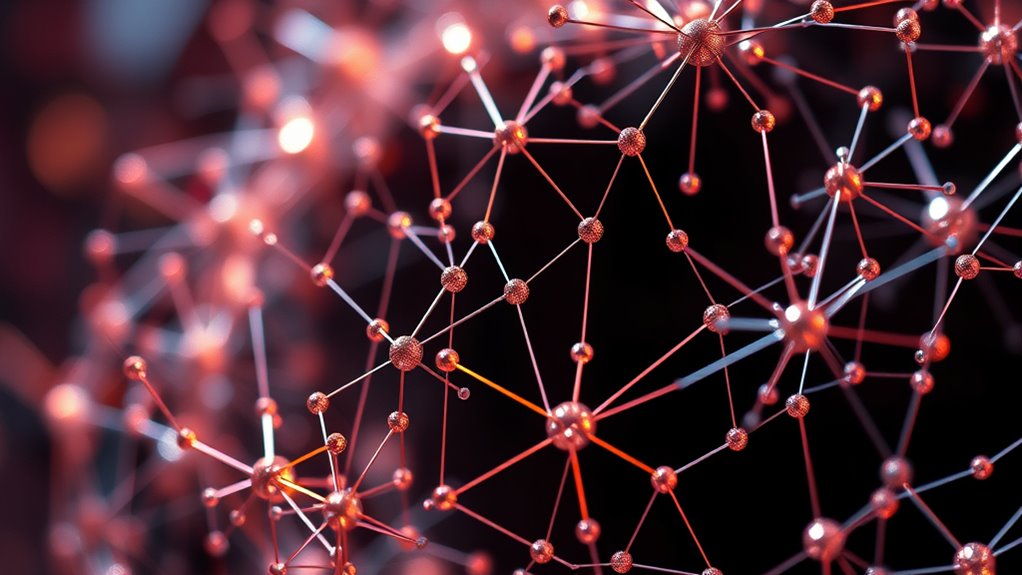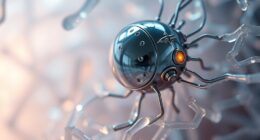Self-assembling nanomachines form through molecular interactions like hydrogen bonds, van der Waals forces, and electrostatic attractions, which guide molecules to organize spontaneously. By selecting specific components and stimuli-responsive elements, you can design structures that assemble precisely and reliably. Techniques such as atomic force microscopy, electron microscopy, and DNA origami help in engineering these systems. Exploring these principles and tools will reveal how to create versatile nanostructures for various innovative applications.
Key Takeaways
- Self-assembly relies on molecular properties like shape, surface chemistry, and environmental conditions to spontaneously form nanostructures.
- Key interactions such as hydrogen bonds, van der Waals forces, electrostatic attractions, and hydrophobic effects drive nanomachine formation.
- Design strategies include selecting specific binding domains, modular components, and stimuli-responsive elements for precise control.
- Techniques like DNA origami, atomic force microscopy, electron microscopy, and surface patterning enable nanostructure engineering.
- Applications span targeted drug delivery, adaptive electronics, environmental remediation, and future programmable, self-healing nanosystems.
Fundamental Concepts of Self-Assembly at the Nanoscale
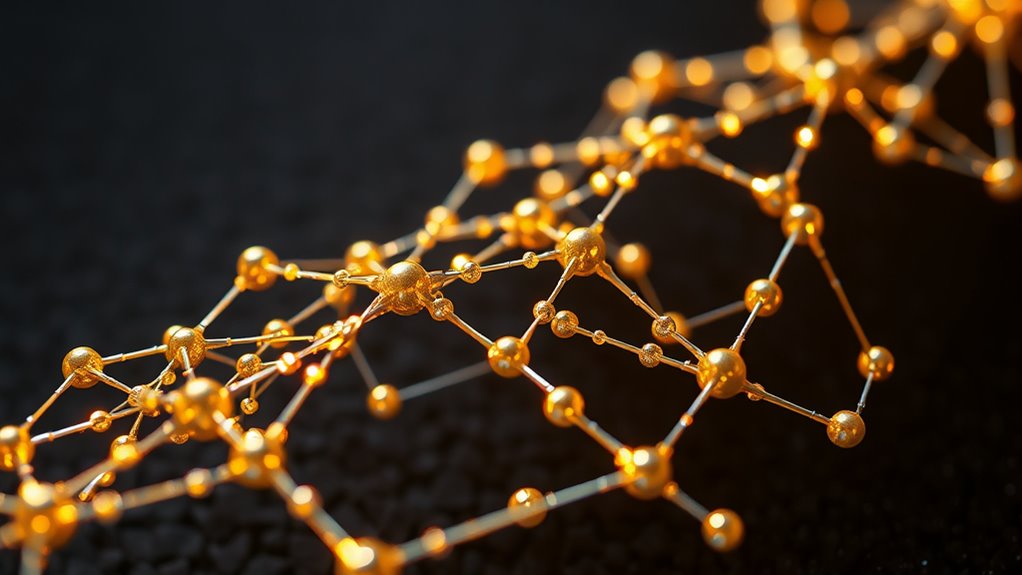
Self-assembly at the nanoscale involves the spontaneous organization of individual components into structured, functional systems without external guidance. You don’t need to manually arrange each part; instead, these components naturally come together through specific interactions. This process relies on the inherent properties of molecules, such as shape, size, and surface chemistry, which guide how they fit and bind with each other. Temperature, concentration, and environmental conditions influence how efficiently self-assembly occurs. The goal is to create precise, reliable structures at tiny scales, which forms the foundation for designing nanomachines. Understanding these fundamental principles helps you predict and control how nanoscale components will organize, paving the way for innovations in medicine, electronics, and materials science.
Molecular Interactions Driving Nanomachine Formation

The success of nanoscale self-assembly hinges on the specific molecular interactions that enable components to recognize, attract, and bind to each other. You rely on forces like hydrogen bonds, van der Waals interactions, electrostatic attractions, and hydrophobic effects to guide assembly. Hydrogen bonds form between complementary functional groups, stabilizing structures through directional interactions. Van der Waals forces, though weak individually, collectively drive close packing of molecules. Electrostatic attractions occur between charged groups, ensuring specificity. Hydrophobic interactions help exclude water, promoting aggregation of nonpolar regions. Additionally, the balance of thermodynamic forces plays a crucial role in determining the stability and pathways of assembly. These interactions work together to produce highly specific, stable arrangements essential for nanomachine function. Understanding these forces allows you to manipulate conditions and molecular designs to control assembly pathways, ensuring the formation of desired nanostructures with precision.
Design Strategies for Programmable Nanostructures

Designing programmable nanostructures involves selecting molecular components and interactions that can be precisely controlled to achieve desired configurations. You need to focus on how molecules connect, fold, and assemble into complex shapes. To enhance control and functionality, consider these strategies:
- Use specific binding domains to dictate assembly pathways.
- Incorporate stimuli-responsive elements to enable environmental control.
- Design modular components for flexible reconfiguration.
- Implement hierarchical assembly to build complex structures from simple units.
Techniques and Tools for Engineering Nanomachines
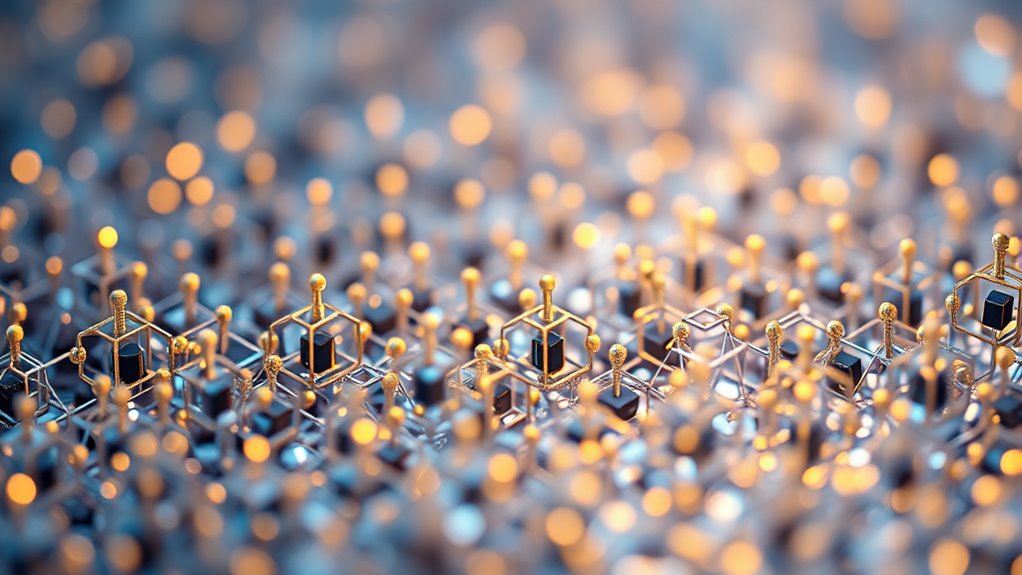
Advances in techniques and tools have revolutionized how we engineer nanomachines, enabling precise control over their assembly and function. Techniques like atomic force microscopy (AFM) allow you to manipulate individual molecules and observe their behavior in real time. Electron microscopy provides detailed imaging at the atomic level, helping you verify structures accurately. You can also employ DNA origami to design complex nanostructures with high precision, guiding self-assembly processes effectively. Surface patterning and lithography enable you to create specific templates and binding sites, directing nanomachine assembly. Additionally, advanced computational tools help simulate interactions and optimize designs before physical construction. These techniques empower you to fine-tune nanomachine components, ensuring reliable performance and facilitating innovations across nanotechnology applications. Incorporating AI-driven safety measures can also help predict and mitigate potential assembly failures, further enhancing the reliability of nanomachines.
Applications and Future Directions of Self-Assembling Systems
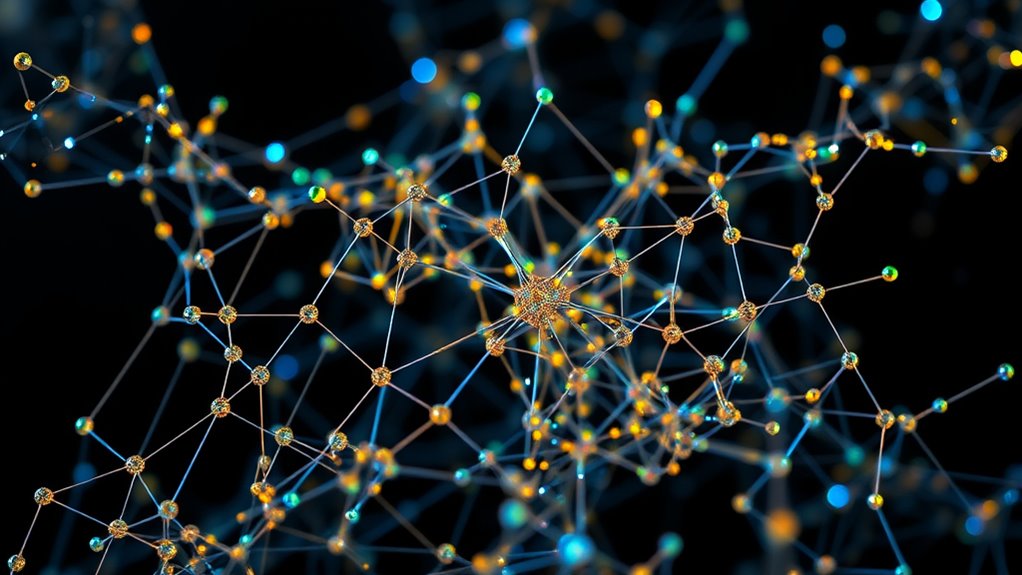
Self-assembling systems are transforming various fields by enabling the autonomous formation of complex structures, which can perform specific functions with minimal human intervention. In the future, you’ll see these systems revolutionize medicine, electronics, environmental remediation, and materials science. They can deliver targeted drug therapies, create adaptive electronic components, clean pollutants, and develop novel materials with tailored properties. To deepen your understanding, consider these key directions:
- Integration into personalized medicine for precise treatments
- Development of adaptive, self-healing materials
- Deployment in environmental cleanup and pollution control
- Advancement of programmable nanosystems for complex tasks
Self-assembly principles are fundamental to the design and functionality of these systems, enabling precise control over their formation and behavior.
These applications will push the boundaries of current technology, opening new possibilities for sustainable and efficient solutions.
Frequently Asked Questions
How Do Environmental Factors Influence Self-Assembly Processes at the Nanoscale?
Environmental factors like temperature, pH, and ionic strength directly impact your self-assembly process at the nanoscale. Higher temperatures can speed up or destabilize assemblies, while pH shifts may alter charge interactions essential for bonding. Ionic strength influences electrostatic interactions, either stabilizing or disrupting structures. By carefully controlling these conditions, you can guide the formation, stability, and functionality of your nanomachines effectively.
What Are the Main Challenges in Scaling up Nanomachine Production?
You face significant hurdles in scaling up nanomachine production, mainly due to maintaining precision and consistency at larger volumes. As you try to move from lab to industry, you’ll encounter issues like reproducibility, cost, and technical limitations. It’s a tough nut to crack, but with advances in automation and manufacturing techniques, you can overcome these challenges and bring nanomachines closer to practical, widespread applications.
Can Self-Assembling Nanomachines Repair Themselves Autonomously?
Yes, self-assembling nanomachines can potentially repair themselves autonomously. They are designed with built-in mechanisms that detect damage and initiate repair processes without external intervention. You might see them use molecular recognition or targeted reassembly to fix broken parts. This ability enhances their durability and functionality, allowing them to operate effectively in complex environments. As technology advances, autonomous self-repair becomes increasingly feasible, making nanomachines more reliable over time.
How Do Quantum Effects Impact Nanomachine Stability and Function?
Quantum effects can remarkably influence nanomachine stability and function. You might see quantum tunneling cause unexpected energy transfers, potentially destabilizing the system. Conversely, quantum coherence could enhance precision and efficiency in operations. These effects require you to carefully design nanomachines, considering quantum behavior, to maintain stability. By controlling environmental factors and material properties, you can harness quantum phenomena to improve nanomachine performance.
What Ethical Considerations Arise From Deploying Nanomachines in Medicine?
You should consider that 85% of people express concerns about nanomachines in medicine. Ethical issues include privacy, consent, and potential misuse. You might worry about unintended side effects or long-term impacts on health and the environment. It’s vital to guarantee transparency, regulate development, and establish guidelines. By addressing these concerns proactively, you can help build trust and assure nanomachines serve humanity responsibly and ethically.
Conclusion
Self-assembling nanomachines open exciting possibilities for future technology, but their full potential depends on your understanding of the underlying principles and techniques. By mastering molecular interactions and design strategies, you can create complex, programmable nanostructures. Will you seize the challenge to innovate at the tiniest scales? Embracing these systems could revolutionize medicine, electronics, and materials—so why not start exploring the fascinating world of nanoscale self-assembly today?
